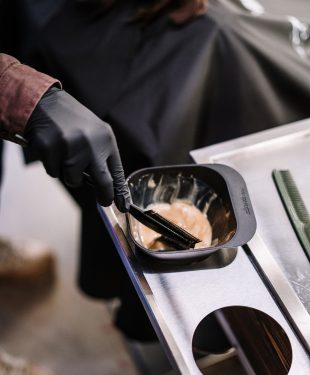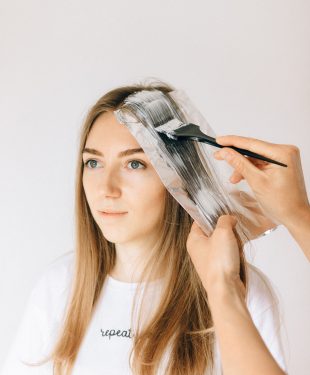Today we are going to give you tips on mastering the art of coloring your hair. Coloring your hair at home has never been more accessible and achievable, with a variety of high-quality products and user-friendly techniques. However, to truly master the art of DIY hair coloring and achieve stunning results that rival professional salon services, it’s essential to know the proper steps and precautions.
This article will guide you through the entire process – from selecting the correct color formula to maintaining your new vibrant shade for weeks on end.
Main Points
- To achieve stunning results when coloring hair at home, it’s essential to choose the right color and formula for your hair type and desired outcome. Conducting a patch test is also crucial before starting.
- Mixing and applying the dye evenly throughout your hair is key to achieving an even color tone. Timing is also important when rinsing out the dye for optimal results.
- Maintaining gorgeous locks with beautiful shades that last longer than expected requires minimizing heat styling, touching up roots regularly, using color-safe products, and avoiding excessive exposure to sunlight or hot tools. Regular conditioning treatments are vital in keeping your newly colored hair feeling soft and looking shiny.
Preparing For Hair Coloring At Home
Choose the right color and formula for your hair type and desired outcome. Conduct a patch test to check for any allergic reactions or adverse effects.
Choosing The Right Color And Formula

Photo by on Pexels
Selecting the perfect color and formula for your hair is a crucial first step in achieving stunning results at home. Begin by considering your desired outcome, whether it’s enhancing your natural shade or opting for a more dramatic change.
To choose the ideal formula, familiarize yourself with the various types available – permanent, demi-permanent, and semi-permanent dyes each offer different benefits depending on your needs.
Permanent hair colors provide long-lasting coverage and are excellent for covering grays or making significant changes to your current hue. Demi-permanent options gradually fade over time but deliver rich hues without as much commitment as their permanent counterparts.
Don’t forget to consider ingredients when selecting a product as well; brands like Ion Permanent Hair Color offer formulas designed to minimize damage while delivering vibrant results (see Important Fact #6).
Conducting A Patch Test
Before diving into coloring your hair, it’s important to conduct a patch test to avoid any possible allergic reactions. To do this, apply a small amount of the dye mixture behind your ear or on your inner elbow and wait for at least 48 hours to see if there are any adverse effects.
If you experience itching, redness, or swelling during this time frame, then it’s best not to continue with the hair color.
Mastering the art of coloring your hair requires careful preparation and attention to detail like conducting a strand test and patch test before moving forward with the actual process.
Don’t forget that while DIY hair dying can be convenient and cost-effective, safety should always come first.
Gathering Necessary Tools And Supplies

Photo by on Pexels
To achieve a beautiful and long-lasting hair color at home, it is crucial to have the right tools and supplies. Firstly, choose a reputable brand of hair dye in your desired shade, whether permanent or semi-permanent.
Other necessary items include gloves for protecting your hands from stains, an old towel to wrap around your shoulders to avoid staining clothing, and clips or rubber bands to divide hair into sections for easier application.
Additionally, ensure that you have access to plenty of cool water for rinsing out the dye after processing time is up. You may also want to invest in a high-quality conditioner designed specifically for colored hair as this will help prolong the vibrancy of your new hue while keeping strands feeling soft and shiny.
Achieving Stunning Results At Home
Mix the hair dye according to instructions and apply it evenly using a tinting brush or applicator bottle, making sure to thoroughly saturate each section of hair for vibrant color.
Mixing And Applying The Dye
Mixing and applying hair dye can seem daunting, but with the right tools and technique, achieving stunning results at home is possible. Start by following the instructions on the package carefully, ensuring that you mix the dye thoroughly before application.
Be sure not to miss any spots or sections of hair as this may lead to uneven color distribution. Also, consider covering your head with a shower cap or plastic wrap while waiting for the dye to set in; this will help retain heat and increase absorption.
Keep in mind that timing is crucial when it comes to coloring hair at home – leave the dye in for too long, and you risk damaging your strands; wash it out too soon, and you may end up with lackluster results.
Timing And Rinsing
After the dye has been applied, it’s important to follow the timing instructions carefully for optimal results. Leaving the color on too long may cause damage, while rinsing too soon could result in uneven color.
Once you’ve rinsed thoroughly with water until it runs clear, apply a conditioner to replenish moisture and seal in shine. It’s recommended that you wait at least 48 hours before washing your hair after coloring to allow time for the cuticle layer to fully close and set in place.
Conditioning Your Hair

Photo by on Pexels
After rinsing out the hair dye, it’s crucial to condition your hair thoroughly. The chemical process of coloring can leave your strands feeling dry and brittle. A good conditioner will help replenish moisture and keep your locks looking healthy and shiny.
Additionally, it’s important to avoid over-washing your newly colored hair as this can strip away the color faster. Opt for sulfate-free shampoos and conditioners that are formulated for color-treated hair to prevent fading and maintain vibrancy.
Maintaining Your Hair Color
Use color-safe products to keep your hair vibrant and healthy, minimize heat styling to prevent damage, touch up roots regularly to maintain the overall look of your hair, and avoid sun exposure and hot tools that can strip away color.
Using Color-Safe Products
It is crucial to use color-safe products for maintaining the longevity of your newly dyed hair after achieving stunning results at home. These products are specially formulated to help preserve and protect the vibrancy of your hair color while preventing fading or damage caused by harsh chemicals found in regular shampoos and conditioners.
If you want even more protection from external factors like heat styling or sun exposure, consider using a leave-in conditioner or a UV-protective spray that shields your hair against harmful UV rays.
When purchasing color-safe products, always check its ingredients list for harmful chemicals like sulfates, parabens, phthalates, or alcohol that can strip away dye pigments from the strands.
Minimizing Heat Styling
Using heat styling tools can be damaging to colored hair and lead to fading or dryness. To minimize this, it’s important to limit the use of hot tools like flat irons and curling wands.
If you do need to use a hot tool, make sure to apply a heat protectant spray before using it on your hair.
Remember that excessive heat can fade color quickly, so try to keep your tools at lower temperatures or reduce usage altogether if possible.
Touching Up Roots Regularly

Photo by on Pexels
To maintain your hair’s color freshness and vibrancy, it is essential to touch up your roots regularly. As a rule of thumb, plan on dyeing your roots every four to six weeks, depending on how quickly they grow out.
When touching up your roots, be sure to use the same hair dye that you used for your initial coloring.
It is important not to overlap the new dye onto already colored hair when doing root touch-ups as this can lead to uneven coloring and even damage or breakage in some cases.
Instead, apply the dye only on the new growth at the roots by dividing your hair into sections using clips or ties before applying.
Avoiding Sun Exposure And Hot Tools
Exposure to direct sunlight and hot tools can cause damage to hair color. UV rays from the sun and high heat can cause hair color to fade faster, resulting in a dull-looking shade.
To shield your hair from harmful UV rays, it’s recommended that you wear a hat or scarf while outdoors for extended periods of time. Additionally, using products that contain SPF protection is also an effective way to minimize color fading caused by exposure to sunlight.
For people who love their hot styling tools but are concerned about damaging their colored hair, using heat-protectant sprays is essential.
Conclusion
Congratulations! You’ve taken the first step towards mastering the art of hair coloring at home. Armed with the knowledge and tips provided in this article, you can now achieve stunning results without ever stepping foot into a salon.
Remember to take your time, conduct a patch test, and choose the right color and formula for your hair texture. Maintaining your new color will require some effort, but using color-safe products and minimizing heat styling will prolong your gorgeous locks.
Read more beauty articles at ClichéMag.com
Images provided by BingAI, Adobe Stock, Flickr, Unsplash, Pexels, Pixabay & Creative Commons


